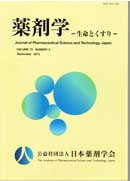Volume 65, Issue 6
Displaying 1-18 of 18 articles from this issue
- |<
- <
- 1
- >
- >|
Foreword
-
2005Volume 65Issue 6 Pages 327
Published: 2005
Released on J-STAGE: April 20, 2019
Download PDF (149K)
Fora
-
2005Volume 65Issue 6 Pages 328-330
Published: 2005
Released on J-STAGE: April 20, 2019
Download PDF (332K) -
2005Volume 65Issue 6 Pages 331-333
Published: 2005
Released on J-STAGE: April 20, 2019
Download PDF (304K)
Relay Plazas
-
2005Volume 65Issue 6 Pages 334-337
Published: 2005
Released on J-STAGE: April 20, 2019
Download PDF (509K) -
2005Volume 65Issue 6 Pages 338-341
Published: 2005
Released on J-STAGE: April 20, 2019
Download PDF (745K)
R&D
-
2005Volume 65Issue 6 Pages 342-347
Published: 2005
Released on J-STAGE: April 20, 2019
Download PDF (1055K)
Research Laboratory
-
2005Volume 65Issue 6 Pages 348-352
Published: 2005
Released on J-STAGE: April 20, 2019
Download PDF (1103K)
Young Researchers
-
2005Volume 65Issue 6 Pages 353-359
Published: 2005
Released on J-STAGE: April 20, 2019
Download PDF (811K) -
2005Volume 65Issue 6 Pages 360-365
Published: 2005
Released on J-STAGE: April 20, 2019
Download PDF (700K)
Current Topics
-
2005Volume 65Issue 6 Pages 366-370
Published: 2005
Released on J-STAGE: April 20, 2019
Download PDF (721K) -
2005Volume 65Issue 6 Pages 371-374
Published: 2005
Released on J-STAGE: April 20, 2019
Download PDF (1264K)
Introduction
-
2005Volume 65Issue 6 Pages 375-380
Published: 2005
Released on J-STAGE: April 20, 2019
Download PDF (692K)
Report
-
2005Volume 65Issue 6 Pages 381-383
Published: 2005
Released on J-STAGE: April 20, 2019
Download PDF (300K)
Regular Articles
-
2005Volume 65Issue 6 Pages 384-389
Published: 2005
Released on J-STAGE: April 20, 2019
Download PDF (478K) -
2005Volume 65Issue 6 Pages 390-400
Published: 2005
Released on J-STAGE: April 20, 2019
Download PDF (1069K)
News
-
2005Volume 65Issue 6 Pages 401-408
Published: 2005
Released on J-STAGE: April 20, 2019
Download PDF (1087K)
-
2005Volume 65Issue 6 Pages 409-410
Published: 2005
Released on J-STAGE: April 20, 2019
Download PDF (218K) -
2005Volume 65Issue 6 Pages 411
Published: 2005
Released on J-STAGE: April 20, 2019
Download PDF (41K)
- |<
- <
- 1
- >
- >|
